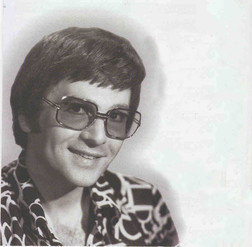


NEWS:
11 shows for December including a new DJ - plus 2025 Festive 50 arriving from Christmas day.
Artist Info
|
Aris San  Image from Discogs  Aris San (1940 - 1992) was a famous Greek singer who immigrated to Israel and was one of the first to use electric guitar in a Greek music setting. Aris San (1940 - 1992) was a famous Greek singer who immigrated to Israel and was one of the first to use electric guitar in a Greek music setting."The status of popular Eastern music changed dramatically in the 1960s, with the eruption of the “Greek” wave of popular music in Israel. “Greek popular music” in this context should be understood as the sound of hybrid nightclub music styles from Athens and Thessaloniki, generally referred to as laika (DeBoer 1996). A dominant feature of this sound is the presence of the bouzouki. This type of Greek music became a favorite style for Israeliborn Eastern Jews as well as for many non-Easterners. This wave is particularly connected to the rise to stardom of Greek singer Aris San. A seventeen-year-old non-Jew from Thessaloniki, San began to frequent Israel after 1956 and to appear in clubs in the port city of Haifa, which was populated by many Jews of Greek origin. Following a love affair with an Israeli girl, San settled in Israel and began to appear at the main venue of Greek music in Israel, the Arianna nightclub in Jaffa, owned by Shmuel Barzilay, a Thessalonician Jew. General Moshe Dayan, at the peak of his political power and popularity in the 1960s, is said to have been a fan of Aris San and even to have intervened to formalize the singer’s legal status. Aris San’s success and that of other contemporary Greek singers who landed in Israel was not a total breakthrough because the presence of Greek popular music in Israel predated his arrival. Nightclubs in Jaffa, such as Arianna, regularly hosted live Greek music and musicians in the 1950s. One may hypothesize that the success of Greek music of the laika style among mizrahi Jews was their way of eluding the quasi boycott of Israeli public culture on Arab music. Sometimes similar in sound and affective appeal, Greek laika music provided a legitimate way to publicly enjoy the type of sounds beloved by Jews from Arab countries. Individuals who became the major producers of musiqa mizrahit in the 1970s, such as Asher Reuveni (personal communication), were exposed to the music of these clubs in their youth and became avid consumers of it. Consequently, the “Greek sound” became one of the main stylistic inspirations of musiqa mizrahit. San’s influence on later musiqa mizrahit cannot be overestimated. One pivotal element was his use of the electric guitar in a high-pitched staccato mode, as an amplified imitation of the sound of the bouzuki. The sound was later copied and became a signature sound of leading musiqa mizrahit tar players such as Moshe Ben Mush and Yehuda Keisar. The song “Boumpam” (in Greek), a huge hit for San in Israel, is exemplary here. In addition to a long guitar solo, the song also includes a short quote from Um Kulthum’s song “Enta Omry” (composed by Mohammed Abd el Wahab), hinting at the proximity to Arab music that his work contained. San’s hit songs in Hebrew, such as “Sigal,” conquered the charts in the 1960s, paving the way in the Israeli public to a new “Mediterranean” sound. San’s songs were simple and light, in sharp contrast with the patriotic content of many popular songs produced during the same period, in the aftermath of the Six-Day War (1967). In terms of melody, “Sigal” is based on a few two-bar motifs repeated in sequence. The minor scale in the verses is not melancholic, as is the case in many mainstream Israeli songs, and the contrasting beginning of the refrain in major sets the spirit of the entire song. Its “Greekness” rests mainly on the sweeping instrumental introduction by San on the bouzouki. ...By the early 1970s, San’s songs became part of mainstream Israeli popular music. Five of his songs are included in the printed collection Lehitim bo`arim (Hot hits; see Kedar 1971) together with popular songs by leading Israeli composers such as Moshe Vilensky, Dov Seltzer, and Nurit Hirsh." This passage is quoted from: Regev, Motti. Popular Music and National Culture in Israel. Ewing, NJ, USA: University of California Press, 2004. p 200-1. Read more on Last.fm. User-contributed text is available under the Creative Commons By-SA License; additional terms may apply. Artist biography from last.fm Some other places to look for information: last.fm Discogs MusicBrainz |
